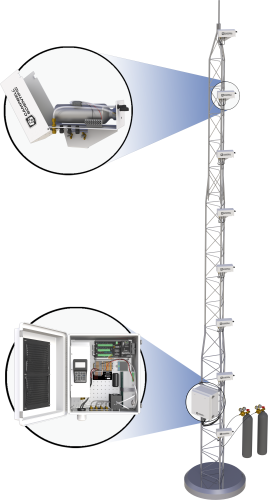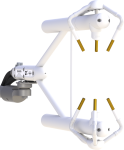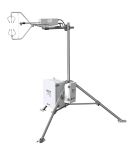
Preprogrammed and low power






Overview
The AP200 is a complete, integrated CO2 and H2O atmospheric profile system. It measures carbon dioxide (CO2) and water vapor (H2O) concentration from up to eight intakes, which are normally spaced along the height of a tower to give a vertical profile. The AP200 is often used in conjunction with an eddy-covariance system to measure the storage term and give a more complete measure of the surface gas exchange.
Read MoreBenefits and Features
- Fully integrated system
- Requires only 13 W (average at 25°C and 12 Vdc)
- Contains a Campbell Scientific CR1000X Measurement and Control Datalogger
- Automatically performs CO2 zero and span
- Automated temperature and pressure control
- Data logger program included
Images

















Related Products
Technical Description
Measurements
Primary:
- CO2 concentration at each intake
- H2O concentration at each intake
- System diagnostic word
Secondary:
- Sample flow rate
- Sample cell pressure
- Sample cell temperature
- Other control variables
| Note: Contact a Campbell Scientific applications engineer from the micromet group for questions or updates regarding the datalogger program. |
Specifications
System Enclosure |
|
| Operating Temperature | -30° to +45°C |
| Power Requirements |
|
| Dimensions | 52.1 x 44.5 x 29.7 cm (20.5 x 17.5 x 11.7 in.) |
| Weight |
|
Pump Module |
|
| Pump Type | Dual-head diaphragm pump with a brushless dc motor |
| Mounting | Mounted in an insulated, temperature-controlled box inside system enclosure |
| Control | Pumping speed is automatically controlled to maintain the pump inlet pressure at the set point |
| Maximum Pumping Speed | 9.0 liters per minute (LPM) |
| Pressure Sensor Range | 15.0 to 115.0 kPa |
| Heater | 8.0 W (turns on/off at 2°C) |
| Warm-up Time | ~50 min (from -30° to +2°C) |
| Fan | 0.7 W (turns on at 50°C and off at 45°C) |
Valve Manifold |
|
| Mounting | Mounted inside system enclosure |
| Inlets | Eight air sample inlets plus one inlet for zero, one inlet for CO2 span, and one inlet for H2O span |
| Connections | 0.25-in Swagelok |
| Mass Flow Sensor | 0 to 1.0 standard liters per minute (SLPM) |
| Heater | 8.0 W (turns on/off at 5°C) |
| Warm-up Time | ~20 min (from -30° to +4°C) |
| Fan | 0.7 W (turns on at 45°C and off at 43°C) |
Intake Assembly |
|
| Filter | 1.0-in diameter, sintered stainless-steel disk filter, 10-micron pore size |
| Orifice Heater | 2 kohm (0.07 W at 12 Vdc) |
| Mixing Volume | 750 mL |
| Sample Connection | 0.25 in. Swagelok |
| Number of Connections for Heater Cable Entry Seals | 3 (1 in, 2 out) |
| Cable Diameter for Heater Cable Entry Seals | 2.8 to 6.6 mm (0.11 to 0.26 in.) |
| Wire Diameter for Heater Cable Screw Terminals | 26 to 12 AWG |
| Wire Stripping Length for Heater Cable Screw Terminals | 5.0 mm (0.2 in.) |
| Screw Tightening Torque for Heater Cable Screw Terminals | 0.4 N•m |
| Orifice Inside Diameter | 0.178 mm (0.007 in.) |
| Dimensions | 31 x 12.5 x 19 cm (12 x 5 x 7.5 in.) |
| Weight | 1.4 kg (3.1 lb) |
Related Documents
Downloads
AP200 CR1000 Program v.2.01 (31.3 KB) 12-01-2021
AP200 CR1000(X) Program.
Compatible with the LI-850.
Note: For those with the LI-840 contact Campbell Scientific for compatible code.
CR1000 OS v.32.07 (4.60 MB) 15-05-2024
Execution of this download installs the CR1000 Operating System and Compiler on your computer. It also updates the CR1000 support files for the CRBasic Editor.
Note: This OS has crossed the 2 Meg CR1000 size limit for remote download. The OS must be downloaded to the 2 Meg CR1000 via direct connect with the Device Configuration Utility. All OS download methods are supported by the 4 Meg CR1000.
Upgrading from versions prior to version 28 of the Operating System will reset the datalogger’s CPU drive. This is due to a change in the format of the file system from FAT16 to FAT32. In order for the datalogger to operate correctly, as part of the upgrade, the CPU drive is formatted to FAT32. Any programs stored and running from the CPU drive will be lost. It is not recommended to update the datalogger’s Operating System over a remote connection where program control regulates the communication equipment (turning it on or off, etc.). In these cases, an on-site visit and a backup using DevConfig’s backup utility is necessary to update the datalogger’s Operating System.
Watch the Video Tutorial: Sending an OS to a Local Datalogger.
In all cases where the datalogger is being updated from an Operating System prior to 28, the use of DevConfig’s backup utility is recommended due to the CPU drive being formatted using the new FAT32 format.
Device Configuration Utility v.2.32.01 (47.7 MB) 15-04-2025
A software utility used to download operating systems and set up Campbell Scientific hardware. Also will update PakBus Graph and the Network Planner if they have been installed previously by another Campbell Scientific software package.
Supported Operating Systems:
Windows 11 or 10 (Both 32 and 64 bit)
Related FAQs
Number of FAQs related to AP200: 52
Expand AllCollapse All
-
No. Because the AP200 has only eight inlets for air samples, it can only operate with a maximum of eight intake assemblies.
-
The automatic zero/span function of the AP200 is designed to do both a zero and a CO2 span. However, it is possible to disable the CO2 span and do only a zero. To do this, set public variable CO2_SPAN_PPM =0.
-
Possibly. For example, to measure advection because of a drainage flow on sloping terrain, an AP200 system could be deployed with two towers, upstream and downstream along the slope, with four intakes on each tower.
-
A dewpoint generator is used as an H2O standard. Dewpoint generators are laboratory instruments and are not suitable for long-term deployment in the field.
-
Yes. Contact Campbell Scientific for a quote to have an application engineer install the system.
-
The intake tubes can be quite long—up to a few hundred meters. Contact an application engineer at Campbell Scientific to ask about specific requirements for an application.
-
Adding sensors to the AP200 is not recommended.
-
The Bowen ratio is defined as β = γ ΔT/ΔH2O, where γ is the psychometric constant, ΔT is the temperature gradient, and ΔH2O is the humidity gradient. The AP200 can measure temperature (with the optional 107-L temperature sensor) and humidity gradients, but its accuracy may not be adequate for a useful Bowen ratio measurement.
-
The AP200 uses ¼ in. tube fittings. Tubing with a 6 mm outer diameter (OD) will not fit, unless a 6 mm to ¼ in. reducer is used on each end of each tube.
-
The LI-840A uses a heater to maintain its sample cell at +50°C. Therefore, it consumes a lot more power at lower temperatures. Below 0°C, the valve heater also requires some power to keep the valves warm.
Articles and Press Releases
Newsletter Articles
Case Studies
This case study discusses the integration of CPEC310 and AP200 systems to explore the theories......read more
The Warra long-term ecological research (LTER) site located in Southwestern Tasmania was founded in 1995......read more
The Warra long-term ecological research (LTER) site located in Southwestern Tasmania was founded in 1995......read more







